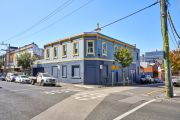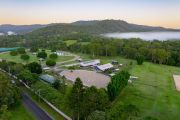
When pubs were like lounge rooms: Why Sydney loves old hotels like the Terminus
All Sydney pubs have a story to tell but it’s likely none has as many colourful chapters in its history as the Terminus Hotel in Pyrmont.
Abandoned since 1984, the ivy-covered Terminus has always piqued the interest of those passing by the corner of Harris and John streets. Interest was revived last month when the property was put on the market and the first images inside the forgotten pub were revealed after more than three decades.
This week, it was announced that the property has been sold for $5 million to a private developer who is reportedly considering a number of uses, including the reactivation of the still-licensed premises.
 The famous ivy covering the Terminus Hotel reflects the changing seasons. Photo: Rebecca Holland
The famous ivy covering the Terminus Hotel reflects the changing seasons. Photo: Rebecca Holland
The current owner, private developer Auswin TWT, plans to retain the south-western carpark of the site for residential development.
“We are delighted that the Terminus Hotel will be brought back to its former glory by a sympathetic purchaser,” says Auswin TWT general manager Stephen Fitzpatrick.
While there are plenty of people hoping for the chance to enjoy a beer there again one day, the Terminus in its first years was much more to the hard-working people of Pyrmont than just a place to drink.
 Old pubs such as the Terminus were the accommodation of choice for single men. Photo: Rebecca Holland
Old pubs such as the Terminus were the accommodation of choice for single men. Photo: Rebecca Holland
According to the National Trust of Australia, Sydney’s earliest working-class pubs – especially those in Pyrmont and Ultimo – were sought out as meeting places because no one had room at home to socialise.
“Pubs have a particular story to tell in Pyrmont,” says National Trust of Australia NSW advocacy manager Graham Quint.
“There were many large workplaces in the area – the CSR sugar factory, the many woolstores, the two power stations, the city incinerator, the sandstone quarries, the railyards and the wharves.
“Scattered amongst these, the housing was as working-class as it ever got in Sydney – small, crowded and rented from indifferent landlords.
“Few houses had yards and indoor space was needed for sleeping. A sitting room served many roles, as dining room, women’s work space, bathing room and kids’ playroom.
“Entertaining visitors at home was out of the question in this world so, in Pyrmont and Ultimo, pubs played an important role as places of domestic relaxation and socialising.”
 Ways Terrace in Pyrmont, Sydney, around the 1920s. Photo: National Library of Australia
Ways Terrace in Pyrmont, Sydney, around the 1920s. Photo: National Library of Australia
Social media has been a big driver in the growing public interest in Australia’s old buildings, especially pubs and abandoned sites.
Photographer Brett Patman, the founder of website Lost Collective, was one of the first granted entry to the Terminus last month to photograph what remains inside.
Having long had an interest in abandoned buildings and being familiar with the local neighbourhood, he was keen to explore what was once a focal point of Pyrmont’s industrial class.
“It’s awesome. Look at it – it’s covered in vines, it’s got the old hand-painted advertisements and the old furniture is still inside,” he says.
Patman, who has photographed many of Australia’s abandoned buildings for Lost Collective, including Callan Park Hospital and the Balmain Leagues Club, believes the Terminus has held up well considering how long it has been unoccupied.
“It’s actually pretty good in comparison to most abandoned places, because it’s been locked up for so long,” he says. “The usual par for the course with abandoned buildings is holes kicked in the wall, windows smashed, ceiling ripped out for the copper.
“The Terminus is still relatively intact.”
Built in 1915, the Terminus was once owned by famous brewing company Tooth and Co. A beer advertisement for Tooths and Reschs on tap is still visible on the exterior of the building facing Harris Street.
Before becoming the Terminus, the pub was named The Coopers Arms. Both iterations would have served an important role in Pyrmont, Mr Quint says.
The National Trust welcomed the news that the Terminus, a “fine example of an early 20th-century hotel”, might be put back into use.
“There is ample scope for additional social and entertainment venues in the vicinity, now that the peninsula has been redeveloped as a residential area,” Mr Quint says.
 The old beer advertising outside the Terminus. Photo: Steven Siewert
The old beer advertising outside the Terminus. Photo: Steven Siewert
Historical perceptions of pub patrons in the area tend to miss the mark, he says. The buildings of the day served as important community hubs rather than just being places to drink.
“They were where family conversations were had and news was exchanged over a shandy,” he says. “Historically, we tend to fixate on the excesses – the drunkenness, the fights and the chauvinism – but the truth was that most working-class people couldn’t afford to drink very much.
“There were many good, hard-working people in Pyrmont who raised happy families and eked out a fair and decent life in difficult conditions.”
Mr Quint says early 20th-century pubs were also important places for accommodation and were the preferred communal home for single men. Pyrmont had many hotels in the early 1900s, each with its own social purpose.
“There were many pubs in Pyrmont, partly because that’s where people congregated but also because each workplace had its own social hierarchy,” he says.
“Foremen didn’t drink with labourers and wharfies didn’t drink with railwaymen – the pub you frequented was a place of familiarity and comfort. You were with ‘your people’ and you knew most faces in the room.”
With Rebecca Holland










